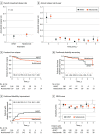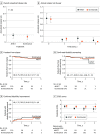Conflict of Interest Disclosures: Dr Kalincik reports grants from National Health and Medical Research Council during the conduct of the study; personal fees from WebMD Global, Eisai, Novartis, Biogen, Merck, Roche, Sanofi Genzyme, Teva, and BioCSL outside the submitted work; grants from Novartis, Biogen, Roche, Merck, and Celgene outside the submitted work; served on scientific advisory boards for MS International Federation and World Health Organization, Bristol Myers Squibb, Roche, Janssen, Sanofi Genzyme, Novartis, Merck, and Biogen; and served on the steering committee for Brain Atrophy Initiative by Sanofi Genzyme. Dr Roos reports personal fees from Novartis, Merck, Roche, and Biogen outside the submitted work; grants from Trish Multiple Sclerosis and Multiple Sclerosis Australia outside the submitted work; served on scientific advisory boards/steering committees for Novartis and Merck; and received conference travel support and/or speaker honoraria from Roche, Novartis, Biogen, Teva, Sanofi-Genzyme, and Merck. Dr Freedman reports grants from Multiple Sclerosis Australia during the conduct of the study; research/educational grants from Sanofi-Genzyme Canada; honoraria/consultation fees from Alexion, Atara Biotherapeutics, Bayer Healthcare, Beigene, BMS (Celgene), EMD Inc, Hoffmann-La Roche, Janssen, Merck Serono, Quanterix, Novartis, Sanofi-Genzyme, and Teva Canada Innovation; serving as a member of company advisory boards or boards of directors for Alexion, Atara Biotherapeutics, Bayer Healthcare, Beigene, BMS (Celgene), Celestra Health, Hoffmann-La Roche, Janssen, McKesson, Merck Serono, Novartis, and Sanofi-Genzyme; and participated in company-sponsored speaker’s bureau for Sanofi-Genzyme and EMD Serono. Dr Massey reports personal fees from Roche, Biogen, Novartis, and Merck during the conduct of the study and serving on the scientific advisory board for Roche. Dr Sutton reports personal fees from Biogen for educational activities, and personal fees for serving on advisory boards of Merck, Bristol Myers Squibb, and Roche outside the submitted work. Dr Macdonell received compensation for traveling, conference fees, and consulting fees from Merck, Teva, Sanofi Genzyme, Biogen Idec, Novartis, Roche, Bristol Myers Squibb, and Celgene. Dr Torkildsen received speaker honoraria from and served on scientific advisory boards for Biogen, Sanofi-Aventis, Merck, and Novartis. Dr Bø received speaker honoraria from Novartis and consultant fees from Viatris. Dr Havrdova reports personal fees from Biogen, Merck trials, Novartis, Roche, Teva, and Czech Ministry of Education outside the submitted work and has been member of advisory boards for Actelion, Biogen, Celgene, Merck Serono, Novartis, and Sanofi Genzyme. Dr Trněný received honoraria from Janssen, Gilead Sciences, Bristol-Myers Squibb, Takeda, Amgen, AbbVie, Roche, MorphoSys, and Novartis; served as an advisor to Takeda, Bristol-Myers Squibb, Incyte, AbbVie, Amgen, Roche, Gilead Sciences, Janssen, MorphoSys, and Novartis; received conference travel support from Gilead Sciences, Takeda, Bristol-Myers Squibb, Roche, Janssen, and AbbVie; and received personal fees from Roche, Gilead Sciences, Novartis, Incyte, Morphosys, Janssen, Takeda, and AstraZeneca outside the submitted work. Dr Kozak reports personal fees from Amgen Czechia, Sobi Czechia, Novartis Czechia, and AbbVie Czechia outside the submitted work. Dr Van der Walt reports grants from the National Health and Medical Research Council of Australia; personal fees from Roche, Merck, Novartis, and Bristol Myers Squibb outside the submitted work; serving on advisory boards and receiving unrestricted research grants from Novartis, Biogen, Merck, and Roche; and receiving speaker’s honoraria and travel support from Novartis, Roche, and Merck. Dr Butzkueven reports grants from Biogen, Roche, Merck, Novartis, Alexion, and CSL to their institution; has carried out contracted research for Novartis, Merck, Roche, and Biogen; has taken part in speakers’ bureaus for Biogen, Genzyme, UCB, Novartis, Roche, and Merck; has received personal compensation from Oxford Health Policy Forum for the Brain Health Steering Committee; travel support from Merck, and is the managing director of the MSBase Foundation and leads the administrative team running this registry from which much of the dataset is extracted. Dr McCombe received speaker fees and travel grants from Novartis, Biogen, T’évalua, Sanofi. Dr Lechner-Scott reports grants from Novartis and Biogen during the conduct of the study; travel compensation from Novartis, Biogen, Roche, and Merck; and her institution receives the honoraria for talks and advisory board commitment as well as research grants from Biogen, Merck, Roche, Teva Pharmaceuticals, and Novartis. Dr Willekens reports consulting/speaker fees paid to their institution from Almirall, BMS-Celgene, Janssen, Merck, Roche, Sanofi-Genzyme, Novartis, and Biogen; grants from Janssen, Roche, Sanofi-Genzyme, Novartis, FWO-TBM, Belgian Charcot Foundation, and Queen Elisabeth Medical Foundation; nonfinancial support from Biogen, Merck, Roche, Sanofi-Genzyme, and Novartis outside the submitted work. Dr Alroughani reports honoraria for speaking and for serving in scientific advisory board from Biogen, Merck, Novartis, Roche, Sanofi, Bayer, and GSK outside the submitted work. Dr Kuhle reports grants from Swiss National Research Foundation, Progressive MS Alliance, Biogen, Bristol Myers Squibb, Celgene, Merck, Novartis, Octave Bioscience, Roche, and Novartis outside the submitted work and speaker fees, research support, or travel support and/or served on advisory boards by Swiss MS Society, Bayer, and Sanofi. Dr Patti reports grants from Biogen, Novartis, and Roche; personal fees from Novartis; speaker honoraria and advisory board fees from Almirall, Bayer, Biogen, Celgene, Merck, Novartis, Roche, Sanofi-Genzyme, and Teva Pharmaceuticals, and research funding from Biogen, Merck, Fondazione Italiana Sclerosi Multipla, Reload Onlus Association, and University of Catania. Dr Duquette served on editorial boards and has been supported to attend meetings by EMD, Biogen, Novartis, Genzyme, and Teva Neuroscience, reports grants from the Canadian Institutes of Health Research, and reports funding for investigator-initiated trials from Biogen, Novartis, and Genzyme. Dr Lugaresi reports personal fees from Alexion, Biogen, Bristol Myers Squibb, Merck Serono, Novartis, Roche, and Sanofi/Genzyme; grants from Novartis and Sanofi/Genzyme; personal compensation for consulting, serving on a scientific advisory board, speaking, or other activities from Roche, Biogen, Bristol Myers Squibb, Merck Serono, Mylan, Novartis, Roche, Sanofi/Genzyme, and Teva; and research grants from Novartis and Sanofi paid to their institution. Dr Khoury reports personal fees from Merck and Novartis outside the submitted work and compensation for serving on scientific advisory boards from Roche and Merck. Dr Slee has participated in, but not received honoraria for, advisory board activity for Biogen, Merck, Bayer Schering, Sanofi Aventis, and Novartis. Dr Hodgkinson reports grants from Merck; clinical trials with Roche, Atara, Biogen, and Novartis during the conduct of the study; personal fees from Novartis (advisory board); personal fees from Merck (advisory boards and speaking tours); grants and travel support for conference attendance from Merck outside the submitted work; honoraria and consulting fees from Novartis, Bayer Schering, and Sanofi; and travel grants from Novartis, Biogen Idec, and Bayer Schering. Dr John reports grants from Biogen and Sanofi, both paid to Monash Health outside the submitted work and is a local principal investigator on commercial studies funded by Novartis, Biogen, Amicus, and Sanofi. Dr Maimone received speaker honoraria for advisory board and travel grants from Almirall, Biogen, Merck, Novartis, Roche, Sanofi-Genzyme, and Teva. Dr van Pesch reports travel grants, research grant, and consultancy paid to their institution from Biogen and Roche; consultancy paid to their institution from Novartis Pharma during the conduct of the study; consultancy paid to their institution from Merck, Sanofi, BMS, Janssen, and Almirall outside the submitted work; and travel grants from Merck Healthcare KGaA (Darmstadt, Germany), Biogen, Sanofi, Bristol Myers Squibb, Almirall, and Roche. Dr Laureys reports compensation for travel, advisory boards, and consultancy paid to their institution from Sanofi-Genzyme, Roche, Teva, Merck, Novartis, Celgene, Biogen, and BMS outside the submitted work. Dr Karabudak reports honoraria or consultancy fees for participating in advisory boards, giving educational lectures, and/or travel and registration coverage for attending scientific congresses or symposia from F. Hoffmann-La Roche Ltd, Sanofi-Genzyme, Merck-Serono, Novartis, Teva, and Biogen Idec/Gen Pharma. Dr La Spitaleri received honoraria as a consultant on scientific advisory boards by Bayer-Schering, Novartis, and Sanofi-Aventis and compensation for travel from Novartis, Biogen, Sanofi Aventis, Teva, and Merck. Dr Csepany received speaker honoraria/ conference travel support from Bayer Schering, Biogen, Merck, Novartis, Roche, Sanofi-Aventis, and Teva. Dr Gouider reports grants from Menactrims and personal fees from Biogen, Hikma, Merck, Roche, and Sanofi outside the submitted work. Dr Mrabet reports grants from Menactrims outside the submitted work. Dr Castillo-Trivino reports personal fees from Almirall, Biogen, Bristol Myers Squibb, Janssen, Merck, Novartis, Roche, and Sanofi-Genzyme outside the submitted work and speaking/consulting fees and/or travel funding from Bayer and Teva. Dr Garber has received research funding from Roche and travel grants and/or honoraria from Merck, Biogen, Roche, and Novartis. Dr Sanchez-Menoyo reports personal fees for speaking honoraria and/or advisory board from Biogen, Merck, Sanofi, Novartis, Almirall, Bayer, Teva, and Sociedad Vasca de Neurologia; travel compensation from Biogen, Novartis, and Merck outside the submitted work. Dr Blanco received speaking/consulting fees from Biogen, Merck, Novartis, Roche, Sanofi-Genzyme, and Sandoz. Dr Weinstock-Guttman reports personal fees from Biogen, Horizon, Sanofi, Labcorp, EMD Serono, and MAPA outside the submitted work and has participated in speaker's bureaus and/or served as a consultant for Novartis, Genentech, Celgene/Bristol Myers Squibb, Sanofi Genzyme, Bayer, Janssen, and Horizon. Dr Taylor reports funding for travel and speaker honoraria from Bayer Schering Pharma, CSL Australia, Biogen, and Novartis and has served on advisory boards for Biogen, Novartis, Roche, and CSL Australia. Dr Fragoso received honoraria as a consultant on scientific advisory boards by Novartis, Teva, Roche, and Sanofi-Aventis and compensation for travel from Novartis, Biogen, Sanofi Aventis, Teva, Roche, and Merck. Dr de Gans reports serving on scientific advisory boards for Roche, Janssen, Sanofi-Genzyme, Novartis, and Merck; received conference fees and travel support from Novartis, Biogen, Sanofi-Genzyme, Teva, AbbVie, and Merck; and received educational event support from Novartis. Dr Kermode received speaker honoraria and scientific advisory board fees from Bayer, BioCSL, Biogen, Genzyme, Innate Immunotherapeutics, Merck, Novartis, Sanofi, Sanofi-Aventis, and Teva. Dr Snowden reports personal fees from Novartis, Jazz, Gilead, Janssen, Medac, and Kiadis Pharma outside the submitted work. No other disclosures were reported.





